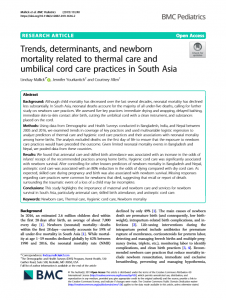
Background
Although child mortality has decreased over the last several decades, neonatal mortality has declined less substantially. In South Asia, neonatal deaths account for the majority of all under-five deaths, calling for further study on newborn care practices. We assessed five key practices: immediate drying and wrapping, delayed bathing, immediate skin-to-skin contact after birth, cutting the umbilical cord with a clean instrument, and substances placed on the cord.
Methods
Using data from Demographic and Health Surveys conducted in Bangladesh, India, and Nepal between 2005 and 2016, we examined trends in coverage of key practices and used multivariable logistic regression to analyze predictors of thermal care and hygienic cord care practices and their associations with neonatal mortality among home births. The analysis excluded deaths on the first day of life to ensure that the exposure to newborn care practices would have preceded the outcome. Given limited neonatal mortality events in Bangladesh and Nepal, we pooled data from these countries.
Results
We found that antenatal care and skilled birth attendance was associated with an increase in the odds of infants’ receipt of the recommended practices among home births. Hygienic cord care was significantly associated with newborn survival. After controlling for other known predictors of newborn mortality in Bangladesh and Nepal, antiseptic cord care was associated with an 80% reduction in the odds of dying compared with dry cord care. As expected, skilled care during pregnancy and birth was also associated with newborn survival. Missing responses regarding care practices were common for newborns that died, suggesting that recall or report of details surrounding the traumatic event of a loss of a child may be incomplete.
Conclusions
This study highlights the importance of maternal and newborn care and services for newborn survival in South Asia, particularly antenatal care, skilled birth attendance, and antiseptic cord care.T